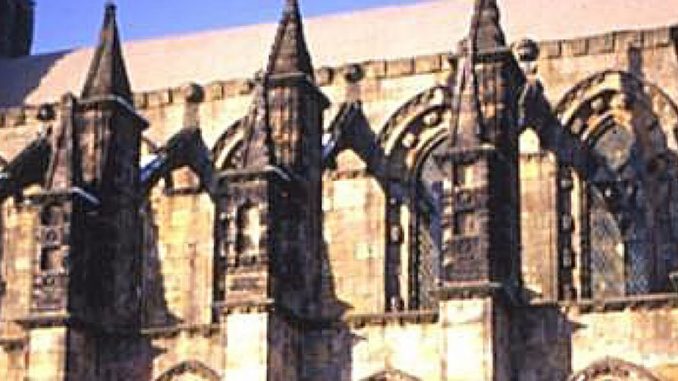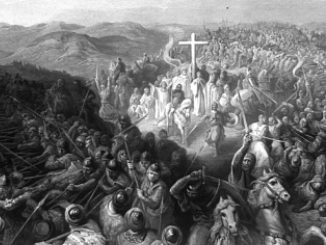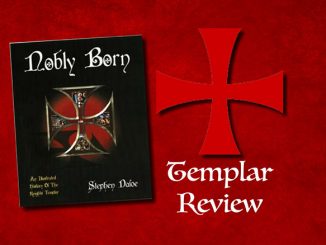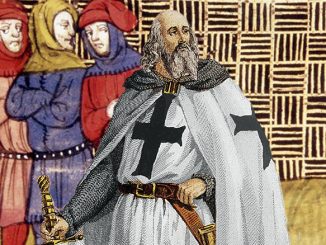
An Interview with John Ritchie on the Rosslyn Ground Scans originally published in Templar History Magazine
THM: Readers of our magazine are very interested in the project that you are soon to commence. For many years popular authors have given a plethora of theories as to what might be buried beneath Rosslyn Chapel. Do you have any theories yourself as to what secrets may lie beneath or within the chapel?
JR: First of all recently I have been accused of being an incomer as far as Rosslyn is concerned, by people from all over the world, who do not know me. So I present my natural CV. In the graveyard down from the Chapel, I have more than 9 relations holding up the hill, including my Grandparents. I was born in Roslin, went to primary school in Roslin. My late Grandfather was the caretaker for the Chapel and the Castle during WWII. So I think that takes care of my son of the soil accreditation.
My Knights Templar connection. Militi Templi Scotia, the Scottish Knights Templar, takes its lineage from Alexander Deuchar circa 1790. The Order has been going since this time, and works on a Jacobite archive and philosophy. I have the honour to be a member of MTS and have been for over 20 years. I am the Grand Herald and press spokesman. Our raison d’ etre has always been to protect Scotland’s Heritage and Culture, and to debunk objects like Stones of Scone becoming the Stone of Destiny, or the monks heart in a piece of lead gutter piping becoming the Bruce heart, even Historic Scotland can be guilty of this, and so the Order has always kept a watching brief, especially on crazy little Belgians that run about calling themselves Prince Michael of Albany.
One of my other hats is secretary to the Midlothian Federation of Community Councils, and we are aware that Rosslyn Chapel Trust Ltd. has received a great deal in money from the Council in Grants. It would be good to see the rest of Roslin and Midlothian benefiting from this, this is simply not happening.
I am afraid speculations have written many books and promulgated too many theories. I once met a chap who was convinced the chapel had been built over an E.T. type spacecraft, and he presented an excellent case, but that’s not the most fanciful theory that I have heard. We must start from fact, the operative not the speculative. If we go back to the last time the vault was used, which to our knowledge was 1650. The last Earl Sinclair to be buried in his complete armour, after being killed at the battle of Dunbar. We can say with some authority that any material contained in the vault must be from this date or before. We know that Rosslyn was a scriptorium; indeed the work cells of the monks can still be seen in the castle. This copying of original manuscripts was started by, said to be the greatest European scholar of his time. Sir Gilbert Hay, William (the builder) Sinclair’s tutor. We know that soldiers in General Monks (Cromwell’s army 1650) removed important manuscripts from Rosslyn castle; some are preserved in the Bodelian Library. I have no doubt that the originals would have been stored in the vault that would include what were called the Anjou papers. We know for example that Mary Queen of Scots mother Mary of Guise visited Sinclair to ask him to return the Holy Rood or Black Rood which was said to be a piece of the true cross, brought to Scotland by Queen Margaret or St Margaret. So from this we can assume that Rosslyn was a depository for important religious items, rather like a wall safe. The Sinclair showed Mary of Guise something very important which convinced her to leave the Holy Rood with Sinclair, and wrote a letter two days later saying thank you for allowing me to see these treasures. Do not worry your secret is safe with me. Therefore the object, or objects must have been of a great status and incredibly important. Most of the references are contained within the Genealogies of the Saintclaires of Rosslyn, which has been republished by Grand Lodge Scotland 2002.
THM: For quite some time there has been speculation about excavating the chapel grounds. As we both know this is unlikely what with the present state of the chapel and the mammoth task of preserving the interior and exterior of the building. Can you tell our readers a bit about the non-intrusive nature of your project?
JR: At this present moment we are still developing the software, which interpolates the data, being received from the very advanced hardware.
A computer model of the surrounding area of Rosslyn is being created, which will have an exact GPS tie in, this will allow us to pin point and create cube form models of the areas of interest. The non-invasive radar survey that we have been using at Temple in Midlothian could revolutionise World archaeology. Without even putting a pin in the ground, the beam can read to the depth of a mile, the equipment works by reading and identifying the atomic weight and value of whatever substance it passes through. The software that is being developed allows you to see what looks like a coloured x-ray. We are still working on the data that we found at Temple, and it has turned up some amazing things.
“Direct from the technical Team. Non Invasive Scanning Non Invasive Scanning is a generic term describing a process, which ’scans’ physical areas of ground, returning information about the materials found within, without disturbing the site under scrutiny.
There are several methods by which this scanning can be performed, but all systems operate under the same principles. A signal beam is sent from the scanning device, which penetrates the ground to be surveyed before returning to a ‘reading head’ on the scanner. Composition of the material, which the beam has encountered, can then be determined, and a ‘map’ of the beams path can then be created to display the returned data. Radar is a good analogy of this process, and indeed most of the systems available are radar based.
The beam is passed through the site repeatedly at identified positions, and the readings from each beam are combined into ‘maps’ of the subsurface area.
Software is currently being developed specifically for the Rosslyn scan which will collate many such maps and generate a fully 3D ‘Virtual’ model of the volume of ground represented by the data. This model can then be used to ‘walk through’ the space analysed. Specific objects ‘discovered’ can be examined and rotated to view them from any angle. Given sufficient passes it will be possible to create a very detailed environment. The resolution of the scanning device will determine the size of object, which will be detected and visualised in the model.
There are several non-invasive systems under consideration. The Rosslyn scan has many peculiarities unique to that site, which make the final selection of a device crucial to the success of the project.”
Scott Grant, Technical Systems Manager, Archaeological Imaging
THM: It is believed that the chapel has a labyrinth of vaults underneath. Do you have any idea at this stage how extensive they may be?
JR: In Father Richard Augustus Hay collected papers, there is a description of entering a series of cave-like vaults, in which were laid the bodies of the Earls of Rosslyn buried in their full armour, unfortunately it does not give us position of these caves. Rosslyn Glen is full of caves cut out of the sandstone. Past surveys in the chapel have shown that even if you go down sixty feet it all appears to be solid, however there are several tunnels running away from the Chapel onto Gardeners Brae which is where the scans would be taking place. Sir Walter Scott in his ballad of Rosabelle writes; –
Seem’d all on fire that chapel proud
Where Roslin’s chiefs uncoffin’d lie,
Each Baron, for a sable shroud,
Sheathed in his iron panoply.
There are twenty of Roslin’s barons bold
Lie buried within that proud chapelle;
Each one the holy vault doth hold
But the sea holds lovely Rosabelle!
Sir Walter Scott was regarded as a great researcher of Scottish history, which is obvious from his body of work.
THM: Indeed he was. You have said that the equipment you are to use is capable of taking readings up to one mile beneath the surface of the earth. Do you anticipate the need to approach anywhere close to these depths?
JR: No, we do not anticipate this depth, however it is good for covering horizontal distances, for example the beams can be directed under the chapel from the brae that surrounds it, without damaging even a blade of grass.
THM: In the event that the surveys discover something beneath the chapel or under the grounds surrounding it, do you think that this will prompt a greater desire to excavate the area and how do you anticipate this would be met by the Rosslyn Chapel Trust?
JR: Obviously I cannot speak for Rosslyn Chapel Trust Ltd. nor would I wish to. We are aware of the possible Pandora’s box scenario, which could emerge from our Scan. It is knowledge we seek, not material treasure. We have an overall government body in Scotland called Historic Scotland, who have the responsibility to grant permission for any excavation of any kind. So in this we have a fail-safe. We have absolutely no wish to excavate, merely to clarify some of the myths that have grown up due to the proliferation of books and television programs.
Indeed the myths and theories have grown at such a pace, I sometimes get the feeling that one day I will walk into the chapel and find it staffed by the crew of the Marie Celeste. Because of the fragility of the chapel, it would be very unwise to excavate. The scan project would also bring media attention, which would benefit the whole area, including Rosslyn Chapel Trust Ltd.
THM: John turning our attention from the potential secrets that lie beneath the chapel and its grounds, you have gone on record as saying that Rosslyn is literally a book in stone. If I may quote you from a recent newspaper interview: “Rosslyn is an amazing building. It is a book in stone but, because the symbolism which is written into the chapel is in a medieval language, we haven’t even cracked the introduction page yet,” As such, is it your belief that as much of Rosslyn’s mystery is above the soil as it is below?
JR: Treasure ,Gold , Fantastic wealth? No I do not think so, the real treasure is in the carvings of the chapel, and there is so much to learn and decipher. Yes correct, for a long time I have called the chapel a book in Stone and for the most part we have not even translated the introduction. We realise that the chapel is multi layered. Animism, overlays biblical philosophy, overlays history, overlays astrology, all written or should I say, carved in long forgotten Mediaeval symbolism, it is an enigmatic onion of a building. Everybody has their theories as we have witnessed from the plethoric publications of books on Rosslyn claiming to have found the answer to the Rosslyn enigma. I am sure the chapel smiles even more enigmatically.
THM: In 1998, when we were both interviewed for A and E’s “Sacred Societies Documentary” we both were opposed to the theory put forth by Dr. Keith Laidler (Head of God) that the green men carved in Rosslyn represented severed heads revered by the Templars. If I may quote you once again from the newspaper article: “We have to go back to the 15th century and read it with a medieval eye to understand what it all means. All these symbols relate to events in history. It is a book created in stone, which brings in all the apostolic religion, laid over by an astrological form which tracks the seasons, and the plants in the seasons.” This comment would certainly explain the proliferation of Green men imagery found in the building as emanating from them one finds a great deal of foliage. Can you enlighten our readers on some of the other vegetative carvings in the chapel?
JR: As we both know the head referred to in the Templar histories would appear to be that of John the Baptist, which would make far more sense considering the Templars were excavating the Temple Mount in Jerusalem said to be very close to the site of Herod’s Palace. As to the Green man representing Christ, the Green man (Cernunnos or the mediaeval Hearne the Hunter) depiction goes back to the early Celts; they believed it to be the ancient symbol of nature’s spirit source, the energy that created the rebirth of the New Year. The layers of carving are incredible, somewhere in the region of two green women and 120 green men (nature’s spirit source) depicted in seasonal ages from Spring (the rebirth of the year), the young man on the east wall to Autumn the bloated, overfed, middle-aged man on the west wall, finishing off with a skull representing winter. All of the fronds or vines that emanate from the top of the Tree of Life pillar (known by some as the apprentice pillar, but only since circa 1800) represent the four different seasons, these fronds made up of plants common to each particular season, create, a garland which runs up and across the pillar arches and frames the windows as if building a protective natural canopy, the druids say that the original Temple was a special tree in the forest. The chapel carvings emulate this belief. Indeed the pillar could be translated as the DNA column or spiral, and the vines of knowledge come straight from the mouths of ancient dragons said to be the guardians of even more ancient, wisdom, as they sit upon the octagon. Telling us perhaps, that this is the Holy Grail.
THM: The Hieroglyphs of Ancient Egypt remained an utter mystery until the discovery of the Rosetta Stone allowed for their decipherment. Is it possible that Rosslyn may have its own Rosetta Stone of sorts and is it possible that this may be one of the things you hope to discover?
JR: Yes there are two codex’s’ that we are working with at the moment which would appear to decipher, certainly the orientation of Rosslyn and its carvings.
THM: John I would like to thank you for taking the time to share information on this fascinating project with our readers. In closing are there any other details you would like to share on the forthcoming ground scans?
JR: When we first set up the first Rosslyn Chapel web site, for the Friends of Rosslyn, Rosslyn.com nearly nine years ago. One of my tasks was to answer e-mail questions sent to the original site, many times I would be asked the same questions, so I put together an answer which could be sent out to the public, I include a copy of this for your readers.
“Thank you for your kind words. We are all pilgrims on the way to knowledge. Rosslyn is a guidebook in stone to knowledge not of this age, and yet still gives us the gateway to the future.
It is a place of great peace and hopefully you will find your own story and journey to your paradise.
There are many secrets at Rosslyn and many authors have found their personal grail, Each find’s his own story locked up in the Chapel’s lexicon.
Many have come and many more will follow as they have done for countless centuries and still the chapel gives of its energy.
Rosslyn is the jewel of the Mason’s Art and the Templar’s Knowledge, and has the message to today’s environmentalists locked up in the spirit of the Green man.
It is a chapel to man’s understanding of earthly things, and a chart to his universe, and perhaps even a gateway to man understanding his perspective in relation to this planet.
Quaere Verum�..John Ritchie indigenous native of Roslin”
All we are doing is providing, a World Forum, and a more democratic voice on Rosslyn, Roslin, Midlothian, Scotland via the scan survey project, and allowing the multi-media world to come with us, on our real medieval quest. Who knows, somebody might find their grail. We have no wish to see any excavations; with this system it is not necessary, besides we must leave our children some mysteries to dream on.
I hope that this might answer some of your questions.
Dominus Vobiscum
About Us
We hope you enjoyed this interviewing the Rosslyn Ground Scans.
TemplarHistory.com was started in the fall of 1997 by Stephen Dafoe, a Canadian author who has written several books on the Templars and related subjects.
Read more like the Rosslyn Ground Scans from our Templar Mysteries Archives – Templar History



